MITSUBISHI COLT 2008 Owner's Manual (in English)
Manufacturer: MITSUBISHI, Model Year: 2008, Model line: COLT, Model: MITSUBISHI COLT 2008Pages: 450, PDF Size: 14.57 MB
Page 331 of 450
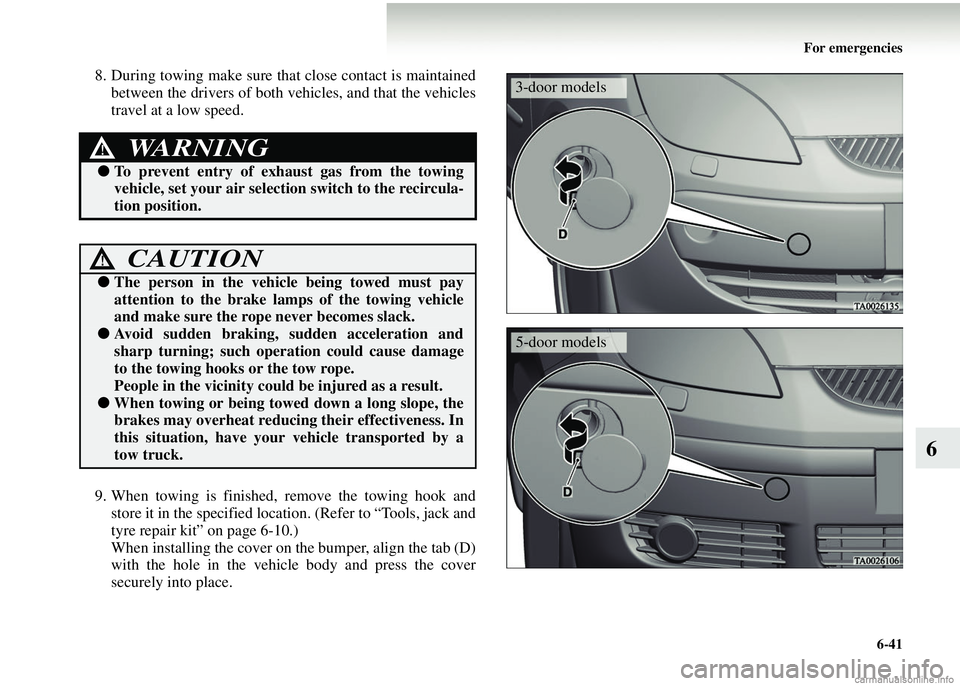
For emergencies6-41
6
8. During towing make sure that close contact is maintainedbetween the drivers of both ve hicles, and that the vehicles
travel at a low speed.
9. When towing is finished, remove the towing hook and store it in the specified location. (Refer to “Tools, jack and
tyre repair kit” on page 6-10.)
When installing the cover on the bumper, align the tab (D)
with the hole in the vehicle body and press the cover
securely into place.
WARNING!
● To prevent entry of exhaust gas from the towing
vehicle, set your air selection switch to the recircula-
tion position.
CAUTION!
●The person in the vehicle being towed must pay
attention to the brake lamps of the towing vehicle
and make sure the rope never becomes slack.
●Avoid sudden braking, sudden acceleration and
sharp turning; such opera tion could cause damage
to the towing hooks or the tow rope.
People in the vicinity coul d be injured as a result.
●When towing or being towed down a long slope, the
brakes may overheat reducing their effectiveness. In
this situation, have your vehicle transported by a
tow truck.
3-door models
5-door models
Page 332 of 450
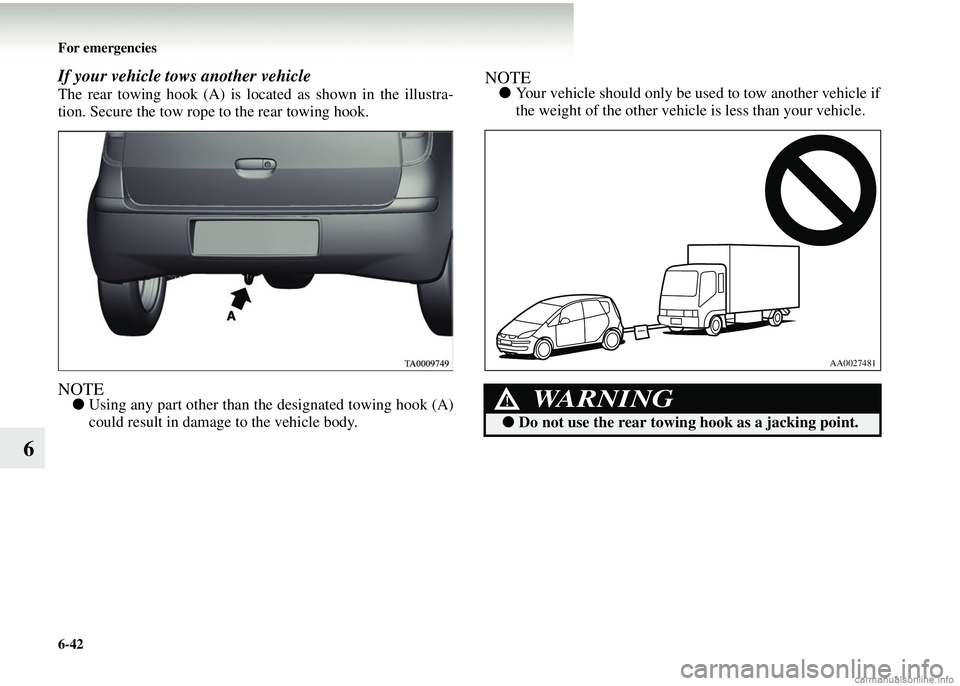
6-42 For emergencies
6
If your vehicle tows another vehicle
The rear towing hook (A) is located as shown in the illustra-
tion. Secure the tow rope to the rear towing hook.
NOTE●Using any part other than the designated towing hook (A)
could result in damage to the vehicle body.
NOTE●Your vehicle should only be used to tow another vehicle if
the weight of the other vehicle is less than your vehicle.
WARNING!
●Do not use the rear towing hook as a jacking point.
AA0027481
Page 333 of 450
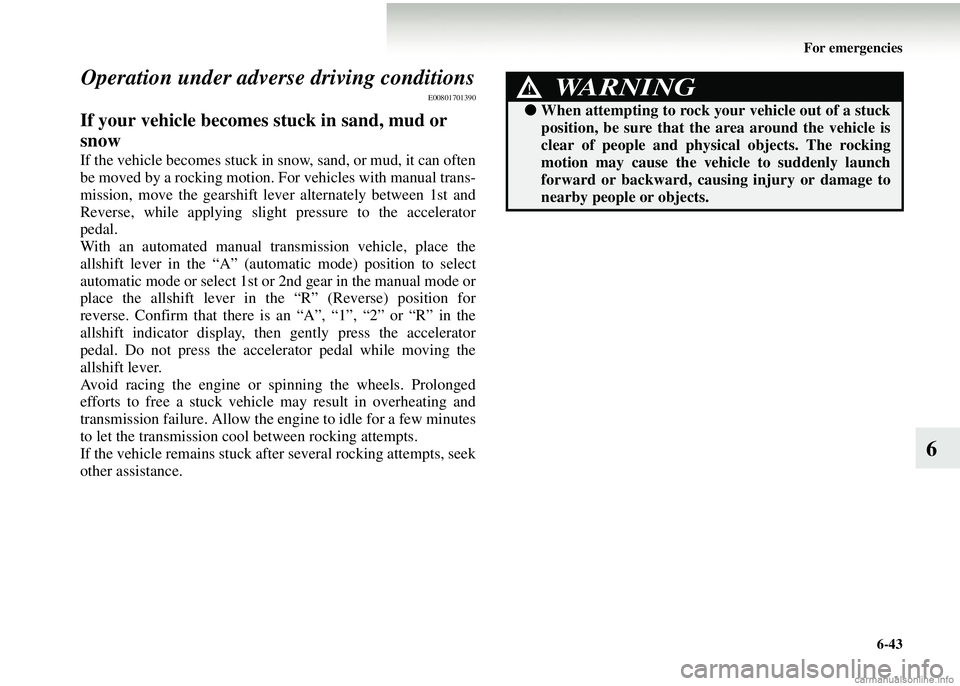
For emergencies6-43
6
Operation under adve
rse driving conditions
E00801701390
If your vehicle becomes stuck in sand, mud or
snow
If the vehicle becomes stuck in snow, sand, or mud, it can often
be moved by a rocking motion. Fo r vehicles with manual trans-
mission, move the gearshift leve r alternately between 1st and
Reverse, while applying slight pressure to the accelerator
pedal.
With an automated manual transmission vehicle, place the
allshift lever in the “A” (automatic mode) position to select
automatic mode or select 1st or 2nd gear in the manual mode or
place the allshift lever in th e “R” (Reverse) position for
reverse. Confirm that there is an “A”, “1”, “2” or “R” in the
allshift indicator display, then gently press the accelerator
pedal. Do not press the acceler ator pedal while moving the
allshift lever.
Avoid racing the engine or spinning the wheels. Prolonged
efforts to free a stuck vehicl e may result in overheating and
transmission failure. Allow the engine to idle for a few minutes
to let the transmission cool between rocking attempts.
If the vehicle remains stuck afte r several rocking attempts, seek
other assistance.
WARNING!
● When attempting to rock your vehicle out of a stuck
position, be sure that the area around the vehicle is
clear of people and physic al objects. The rocking
motion may cause the vehicle to suddenly launch
forward or backward, causing injury or damage to
nearby people or objects.
Page 334 of 450
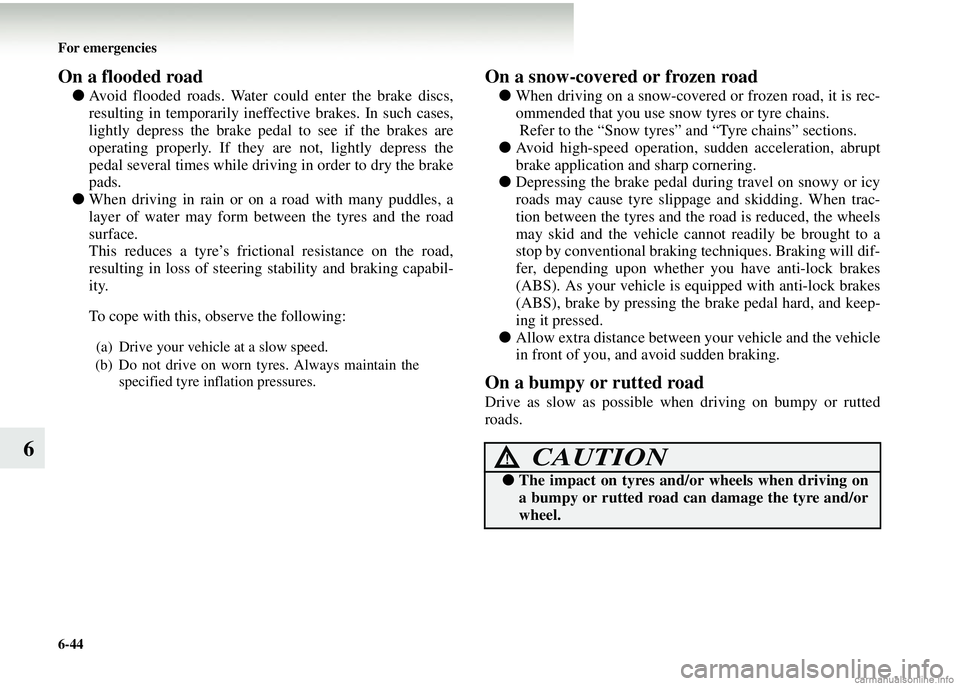
6-44 For emergencies
6
On a flooded road
●Avoid flooded roads. Water could enter the brake discs,
resulting in temporarily ineff ective brakes. In such cases,
lightly depress the brake pedal to see if the brakes are
operating properly. If they are not, lightly depress the
pedal several times while driving in order to dry the brake
pads.
● When driving in rain or on a road with many puddles, a
layer of water may form between the tyres and the road
surface.
This reduces a tyre’s frictional resistance on the road,
resulting in loss of steering stability and braking capabil-
ity.
To cope with this, observe the following:
On a snow-covered or frozen road
●When driving on a snow-covered or frozen road, it is rec-
ommended that you use snow tyres or tyre chains.
Refer to the “Snow tyres” and “Tyre chains” sections.
● Avoid high-speed operation, sudden acceleration, abrupt
brake application and sharp cornering.
● Depressing the brake pedal during travel on snowy or icy
roads may cause tyre slippage and skidding. When trac-
tion between the tyres and the road is reduced, the wheels
may skid and the vehicle cannot readily be brought to a
stop by conventional braking techniques. Braking will dif-
fer, depending upon whether you have anti-lock brakes
(ABS). As your vehicle is equipped with anti-lock brakes
(ABS), brake by pressing th e brake pedal hard, and keep-
ing it pressed.
● Allow extra distance between yo ur vehicle and the vehicle
in front of you, and avoid sudden braking.
On a bumpy or rutted road
Drive as slow as possible when driving on bumpy or rutted
roads.
(a) Drive your vehicle at a slow speed.
(b) Do not drive on worn tyres. Always maintain the specified tyre inflation pressures.
CAUTION!
●The impact on tyres and/ or wheels when driving on
a bumpy or rutted road can damage the tyre and/or
wheel.
Page 335 of 450
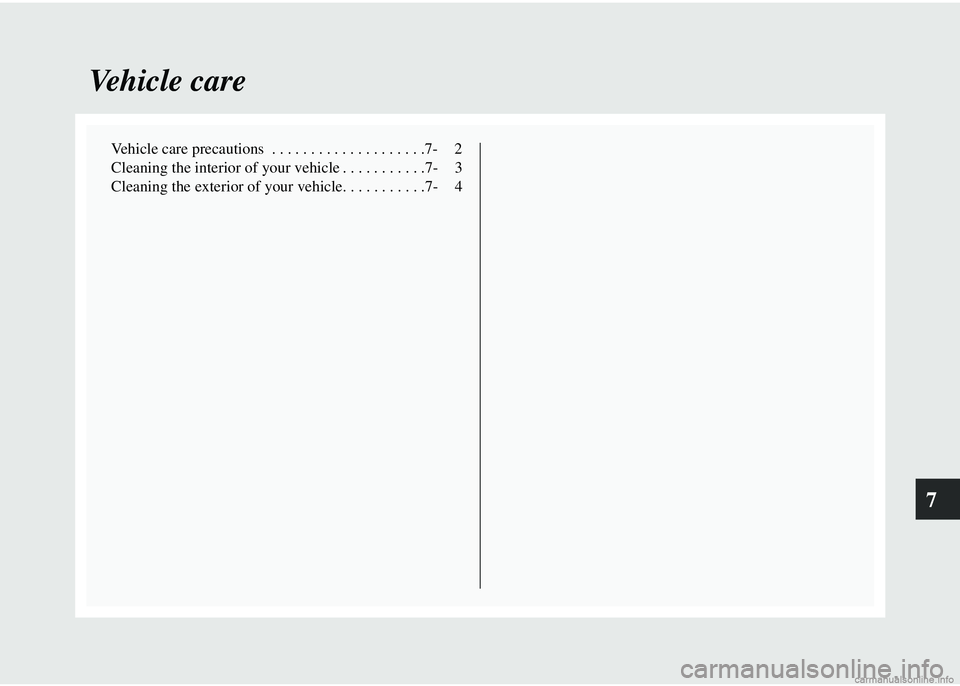
7
Vehicle care
Vehicle care precautions . . . . . . . . . . . . . . . . . . . .7- 2
Cleaning the interior of your vehicle . . . . . . . . . . .7- 3
Cleaning the exterior of your vehicle. . . . . . . . . . .7- 4
Page 336 of 450
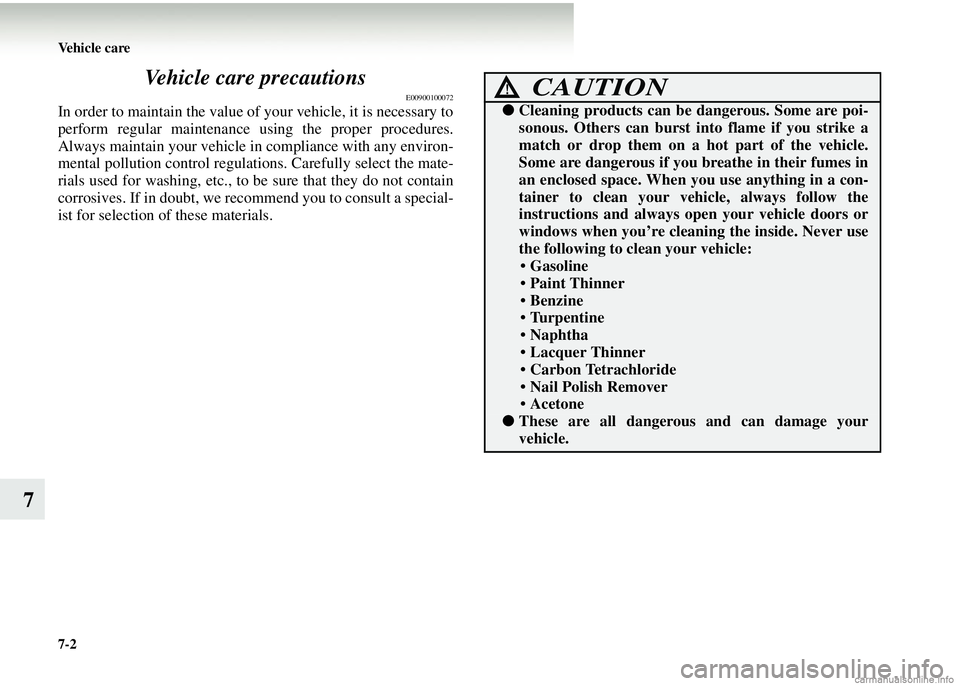
7-2 Vehicle care
7Vehicle care precautions
E00900100072
In order to maintain the value of your vehicle, it is necessary to
perform regular maintenance using the proper procedures.
Always maintain your vehicle
in compliance with any environ-
mental pollution control regulations. Carefully select the mate-
rials used for washing, etc., to be sure that they do not contain
corrosives. If in doubt, we reco mmend you to consult a special-
ist for selection of these materials.
CAUTION!
● Cleaning products can be dangerous. Some are poi-
sonous. Others can burst into flame if you strike a
match or drop them on a hot part of the vehicle.
Some are dangerous if you breathe in their fumes in
an enclosed space. When you use anything in a con-
tainer to clean your vehi cle, always follow the
instructions and always open your vehicle doors or
windows when you’re cleani ng the inside. Never use
the following to clean your vehicle:
• Gasoline
• Paint Thinner
• Benzine
• Turpentine
• Naphtha
• Lacquer Thinner
• Carbon Tetrachloride
• Nail Polish Remover
• Acetone
● These are all dangerous and can damage your
vehicle.
Page 337 of 450
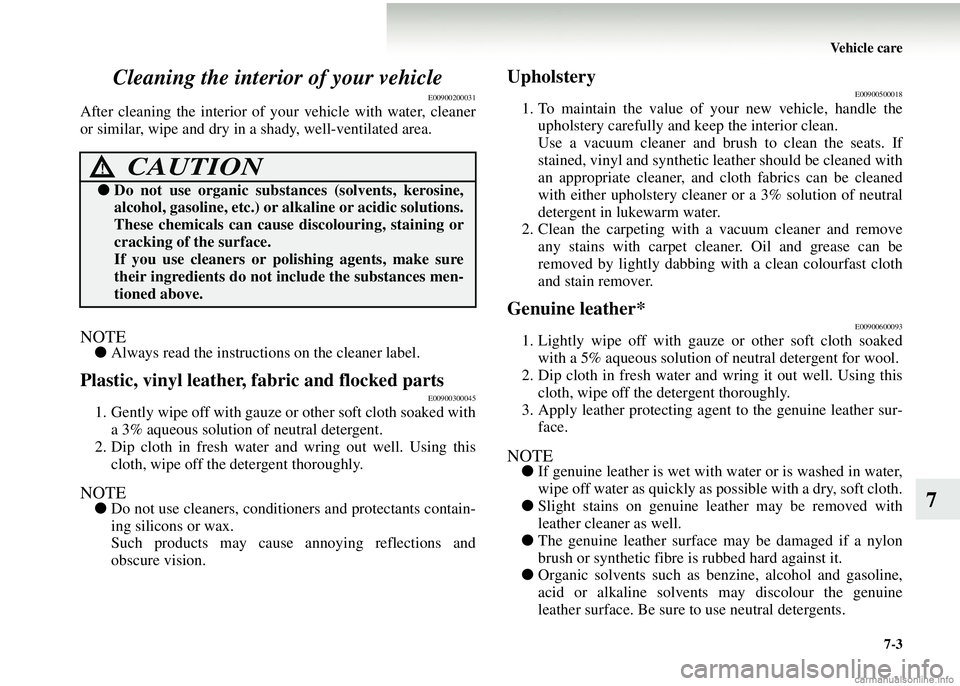
Vehicle care7-3
7
Cleaning the interior of your vehicle
E00900200031
After cleaning the interior of your vehicle with water, cleaner
or similar, wipe and dry in a shady, well-ventilated area.
NOTE●
Always read the instructio ns on the cleaner label.
Plastic, vinyl leather, fabric and flocked partsE00900300045
1. Gently wipe off with gauze or other soft cloth soaked with
a 3% aqueous solution of neutral detergent.
2. Dip cloth in fresh water and wring out well. Using this cloth, wipe off the detergent thoroughly.
NOTE● Do not use cleaners, conditioners and protectants contain-
ing silicons or wax.
Such products may cause annoying reflections and
obscure vision.
UpholsteryE00900500018
1. To maintain the value of your new vehicle, handle the
upholstery carefully and k eep the interior clean.
Use a vacuum cleaner and brush to clean the seats. If
stained, vinyl and synthetic leather should be cleaned with
an appropriate cleaner, and cloth fabrics can be cleaned
with either upholstery cleaner or a 3% solution of neutral
detergent in lukewarm water.
2. Clean the carpeting with a vacuum cleaner and remove
any stains with carpet cleaner. Oil and grease can be
removed by lightly dabbing with a clean colourfast cloth
and stain remover.
Genuine leather*E00900600093
1. Lightly wipe off with gauze or other soft cloth soaked
with a 5% aqueous solution of neutral detergent for wool.
2. Dip cloth in fresh water and wring it out well. Using this cloth, wipe off the detergent thoroughly.
3. Apply leather protecting agent to the genuine leather sur- face.
NOTE● If genuine leather is wet with water or is washed in water,
wipe off water as quickly as possible with a dry, soft cloth.
● Slight stains on genuine leather may be removed with
leather cleaner as well.
● The genuine leather surface may be damaged if a nylon
brush or synthetic fibre is rubbed hard against it.
● Organic solvents such as benzine, alcohol and gasoline,
acid or alkaline solvents may discolour the genuine
leather surface. Be sure to use neutral detergents.
CAUTION!
●Do not use organic substances (solvents, kerosine,
alcohol, gasoline, etc.) or alkaline or acidic solutions.
These chemicals can cause discolouring, staining or
cracking of the surface.
If you use cleaners or po lishing agents, make sure
their ingredients do not in clude the substances men-
tioned above.
Page 338 of 450
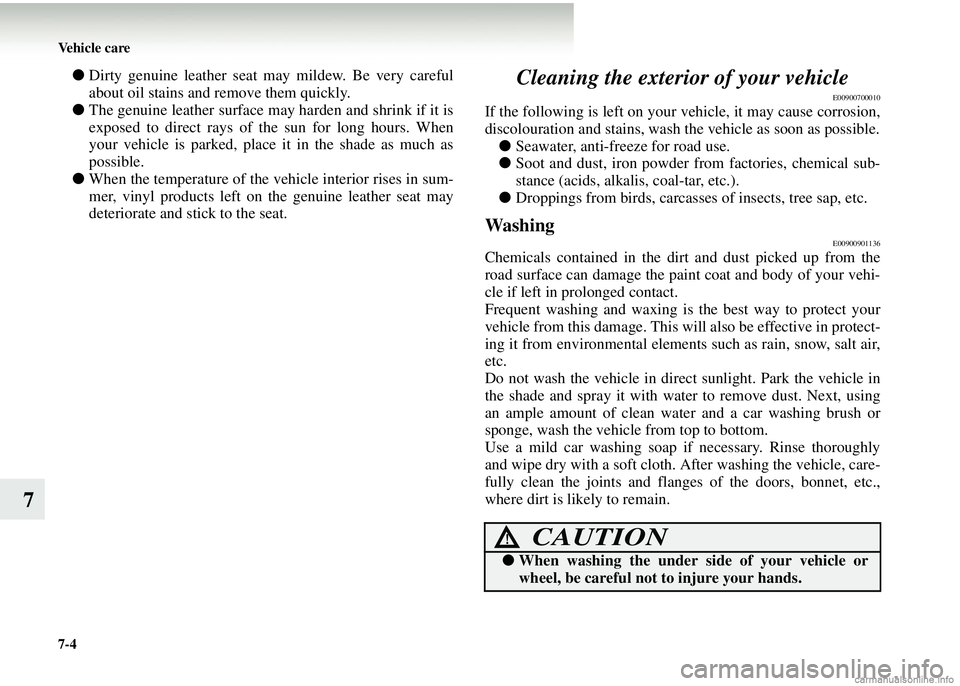
7-4 Vehicle care
7
●Dirty genuine leather seat may mildew. Be very careful
about oil stains and remove them quickly.
● The genuine leather surface may harden and shrink if it is
exposed to direct rays of the sun for long hours. When
your vehicle is parked, place it in the shade as much as
possible.
● When the temperature of the ve hicle interior rises in sum-
mer, vinyl products left on the genuine leather seat may
deteriorate and stick to the seat.Cleaning the exterior of your vehicle
E00900700010
If the following is left on your vehicle, it may cause corrosion,
discolouration and stains, wash the vehicle as soon as possible.
● Seawater, anti-freeze for road use.
● Soot and dust, iron powder from factories, chemical sub-
stance (acids, alkali s, coal-tar, etc.).
● Droppings from birds, carcasse s of insects, tree sap, etc.
Wa s h i n gE00900901136
Chemicals contained in the dirt and dust picked up from the
road surface can damage the paint coat and body of your vehi-
cle if left in prolonged contact.
Frequent washing and waxing is the best way to protect your
vehicle from this damage. This wi ll also be effective in protect-
ing it from environmental elements such as rain, snow, salt air,
etc.
Do not wash the vehicle in dir ect sunlight. Park the vehicle in
the shade and spray it with water to remove dust. Next, using
an ample amount of clean wate r and a car washing brush or
sponge, wash the vehicle from top to bottom.
Use a mild car washing soap if necessary. Rinse thoroughly
and wipe dry with a soft cloth. After washing the vehicle, care-
fully clean the joints and flanges of the doors, bonnet, etc.,
where dirt is likely to remain.
CAUTION!
● When washing the under side of your vehicle or
wheel, be careful not to injure your hands.
Page 339 of 450
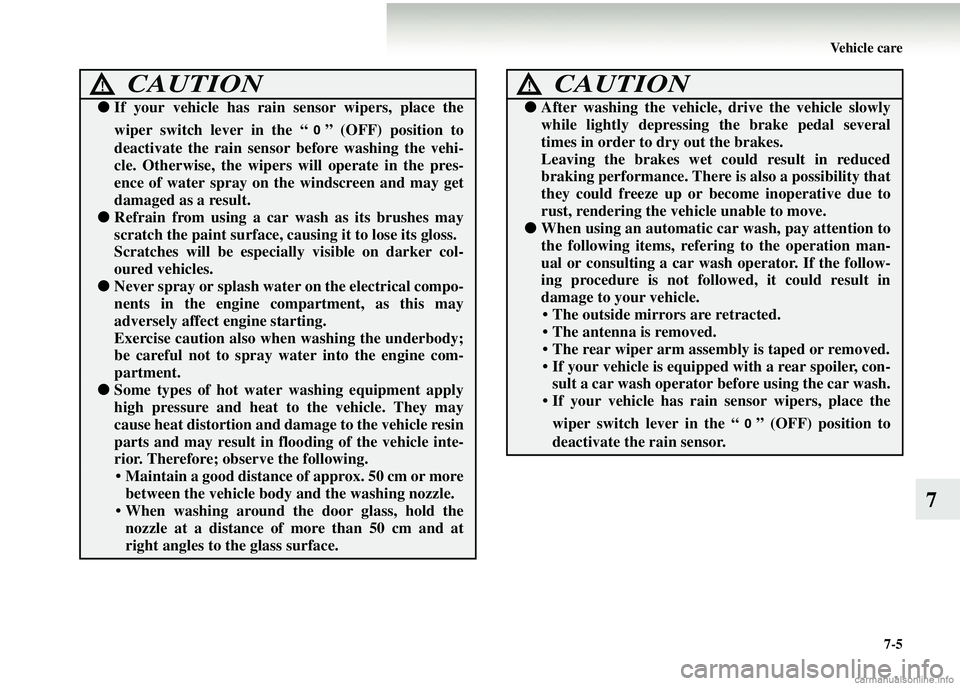
Vehicle care7-5
7
●If your vehicle has rain sensor wipers, place the
wiper switch lever in the “ ” (OFF) position to
deactivate the rain sensor before washing the vehi-
cle. Otherwise, the wipers will operate in the pres-
ence of water spray on the windscreen and may get
damaged as a result.
● Refrain from using a car wash as its brushes may
scratch the paint surface, ca using it to lose its gloss.
Scratches will be especially visible on darker col-
oured vehicles.
● Never spray or splash water on the electrical compo-
nents in the engine compartment, as this may
adversely affect engine starting.
Exercise caution also when washing the underbody;
be careful not to spray wa ter into the engine com-
partment.
● Some types of hot water washing equipment apply
high pressure and heat to the vehicle. They may
cause heat distortion and damage to the vehicle resin
parts and may result in floo ding of the vehicle inte-
rior. Therefore; ob serve the following.
• Maintain a good distance of approx. 50 cm or more
between the vehicle body and the washing nozzle.
• When washing around the door glass, hold the
nozzle at a distance of more than 50 cm and at
right angles to the glass surface.
CAUTION!
● After washing the vehicle, drive the vehicle slowly
while lightly depressing the brake pedal several
times in order to dry out the brakes.
Leaving the brakes wet could result in reduced
braking performance. There is also a possibility that
they could freeze up or b ecome inoperative due to
rust, rendering the vehicle unable to move.
● When using an automatic car wash, pay attention to
the following items, referi ng to the operation man-
ual or consulting a car wash operator. If the follow-
ing procedure is not followed, it could result in
damage to your vehicle.
• The outside mirrors are retracted.
• The antenna is removed.
• The rear wiper arm assembly is taped or removed.
• If your vehicle is equipped with a rear spoiler, con- sult a car wash operator be fore using the car wash.
• If your vehicle has rain sensor wipers, place the
wiper switch lever in th e “ ” (OFF) position to
deactivate the rain sensor.
CAUTION!
Page 340 of 450
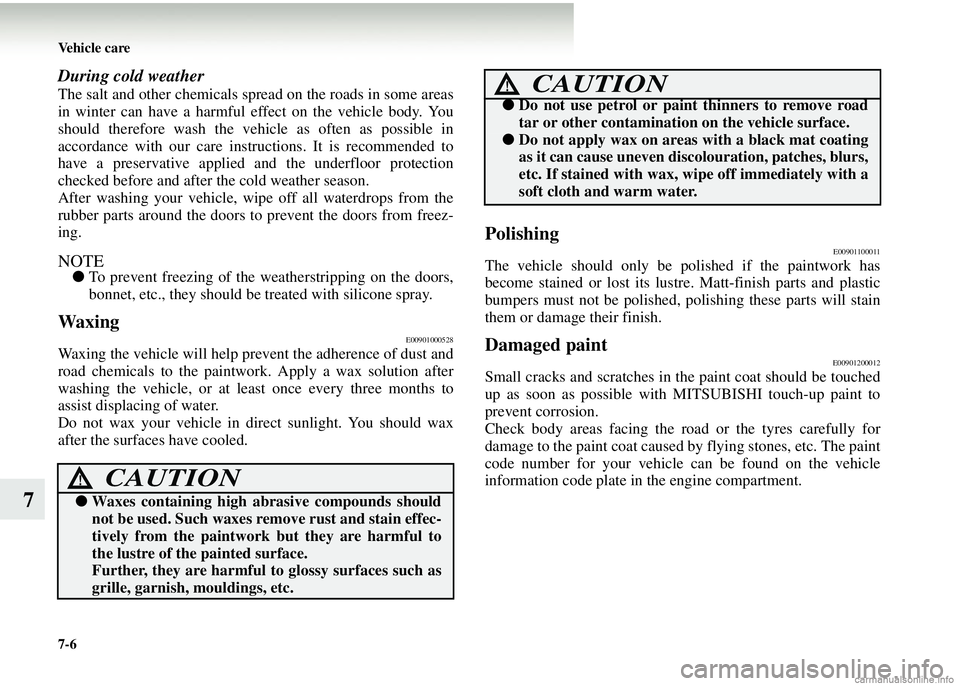
7-6 Vehicle care
7
During cold weather
The salt and other chemicals spread on the roads in some areas
in winter can have a harmful effect on the vehicle body. You
should therefore wash the ve hicle as often as possible in
accordance with our care instruc tions. It is recommended to
have a preservative applied an d the underfloor protection
checked before and after the cold weather season.
After washing your vehicle, wipe off all waterdrops from the
rubber parts around the doors to prevent the doors from freez-
ing.
NOTE● To prevent freezing of the w eatherstripping on the doors,
bonnet, etc., they should be treated with silicone spray.
WaxingE00901000528
Waxing the vehicle will help prev ent the adherence of dust and
road chemicals to the paintwor k. Apply a wax solution after
washing the vehicle, or at least once every three months to
assist displacing of water.
Do not wax your vehicle in direct sunlight. You should wax
after the surfaces have cooled.
PolishingE00901100011
The vehicle should only be polished if the paintwork has
become stained or lost its lustre. Matt-finish parts and plastic
bumpers must not be polished, polishing these parts will stain
them or damage their finish.
Damaged paintE00901200012
Small cracks and scratches in th e paint coat should be touched
up as soon as possible with MITSUBISHI touch-up paint to
prevent corrosion.
Check body areas facing the road or the tyres carefully for
damage to the paint coat caused by flying stones, etc. The paint
code number for your vehicle can be found on the vehicle
information code plate in the engine compartment.
CAUTION!
●Waxes containing high abrasive compounds should
not be used. Such waxes rem ove rust and stain effec-
tively from the paintwork but they are harmful to
the lustre of the painted surface.
Further, they are harmful to glossy surfaces such as
grille, garnish, mouldings, etc.
● Do not use petrol or paint thinners to remove road
tar or other contamination on the vehicle surface.
●Do not apply wax on areas with a black mat coating
as it can cause uneven disc olouration, patches, blurs,
etc. If stained with wax, wipe off immediately with a
soft cloth and warm water.
CAUTION!